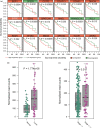Transcriptomic analyses of RNA-binding proteins reveal eIF3c promotes cell proliferation in hepatocellular carcinoma
- PMID: 28231410
- PMCID: PMC5448617
- DOI: 10.1111/cas.13209
Transcriptomic analyses of RNA-binding proteins reveal eIF3c promotes cell proliferation in hepatocellular carcinoma
Abstract
RNA-binding proteins (RBPs) play fundamental roles in the RNA life cycle. The aberrant expression of RBPs is often observed in human disease, including cancer. In this study, we screened for the expression levels of 1542 human RBPs in The Cancer Genome Atlas liver hepatocellular carcinoma samples and found 92 consistently upregulated RBP genes in HCC compared with normal samples. Additionally, we undertook a Kaplan-Meier analysis and found that high expression of 15 RBP genes was associated with poor prognosis in patients with HCC. Furthermore, we found that eIF3c promotes HCC cell proliferation in vitro as well as tumorigenicity in vivo. Gene Set Enrichment Analysis showed that high eIF3c expression is positively associated with KRAS, vascular endothelial growth factor, and Hedgehog signaling pathways, all of which are closely associated with specific cancer-related gene sets. Our study provides the basis for further investigation of the molecular mechanism by which eIF3c promotes the development and progression of HCC.
Keywords: Cell proliferation; RNA binding-proteins; eukaryotic translation initiation factor 3 subunit C; hepatocellular carcinoma; the Cancer Genome Atlas.
© 2017 The Authors. Cancer Science published by John Wiley & Sons Australia, Ltd on behalf of Japanese Cancer Association.
Figures




Similar articles
-
Rpn10 promotes tumor progression by regulating hypoxia-inducible factor 1 alpha through the PTEN/Akt signaling pathway in hepatocellular carcinoma.Cancer Lett. 2019 Apr 10;447:1-11. doi: 10.1016/j.canlet.2019.01.020. Epub 2019 Jan 20. Cancer Lett. 2019. PMID: 30673593
-
Identification of an RNA binding protein-related gene signature in hepatocellular carcinoma patients.Mol Med. 2020 Dec 9;26(1):125. doi: 10.1186/s10020-020-00252-5. Mol Med. 2020. PMID: 33297932 Free PMC article.
-
Development and validation of an RNA binding protein-associated prognostic model for hepatocellular carcinoma.BMC Cancer. 2020 Nov 23;20(1):1136. doi: 10.1186/s12885-020-07625-3. BMC Cancer. 2020. PMID: 33228611 Free PMC article.
-
Exploring RNA binding proteins in hepatocellular carcinoma: insights into mechanisms and therapeutic potential.J Exp Clin Cancer Res. 2025 Apr 24;44(1):130. doi: 10.1186/s13046-025-03395-7. J Exp Clin Cancer Res. 2025. PMID: 40275278 Free PMC article. Review.
-
The role of RNA binding proteins in hepatocellular carcinoma.Adv Drug Deliv Rev. 2022 Mar;182:114114. doi: 10.1016/j.addr.2022.114114. Epub 2022 Jan 19. Adv Drug Deliv Rev. 2022. PMID: 35063534 Review.
Cited by
-
RNA m6A methylation regulators in ovarian cancer.Cancer Cell Int. 2021 Nov 18;21(1):609. doi: 10.1186/s12935-021-02318-8. Cancer Cell Int. 2021. PMID: 34794452 Free PMC article. Review.
-
Hypoxia-Induced Adaptations of miRNomes and Proteomes in Melanoma Cells and Their Secreted Extracellular Vesicles.Cancers (Basel). 2020 Mar 14;12(3):692. doi: 10.3390/cancers12030692. Cancers (Basel). 2020. PMID: 32183388 Free PMC article.
-
Eukaryotic initiation factor 3, subunit C silencing inhibits cell proliferation and promotes apoptosis in human ovarian cancer cells.Biosci Rep. 2019 Aug 5;39(8):BSR20191124. doi: 10.1042/BSR20191124. Print 2019 Aug 30. Biosci Rep. 2019. PMID: 31316002 Free PMC article.
-
The mRNA-binding Protein TTP/ZFP36 in Hepatocarcinogenesis and Hepatocellular Carcinoma.Cancers (Basel). 2019 Nov 8;11(11):1754. doi: 10.3390/cancers11111754. Cancers (Basel). 2019. PMID: 31717307 Free PMC article.
-
The m6A reader YTHDF1 promotes ovarian cancer progression via augmenting EIF3C translation.Nucleic Acids Res. 2020 Apr 17;48(7):3816-3831. doi: 10.1093/nar/gkaa048. Nucleic Acids Res. 2020. PMID: 31996915 Free PMC article.
References
-
- Stewart B, Wild C. World Cancer Report 2014. Lyon, Geneva: International Agency for Research on Cancer, 2014. - PubMed
MeSH terms
Substances
LinkOut - more resources
Full Text Sources
Other Literature Sources
Medical
Miscellaneous

